Part of a series of articles titled Alaska Park Science Volume 20 Issue 1 - Parks as Proving Grounds.
Article
An Introduction to Some of the High-flying Technology Used to Study the Movements of Alaska’s Migratory Birds
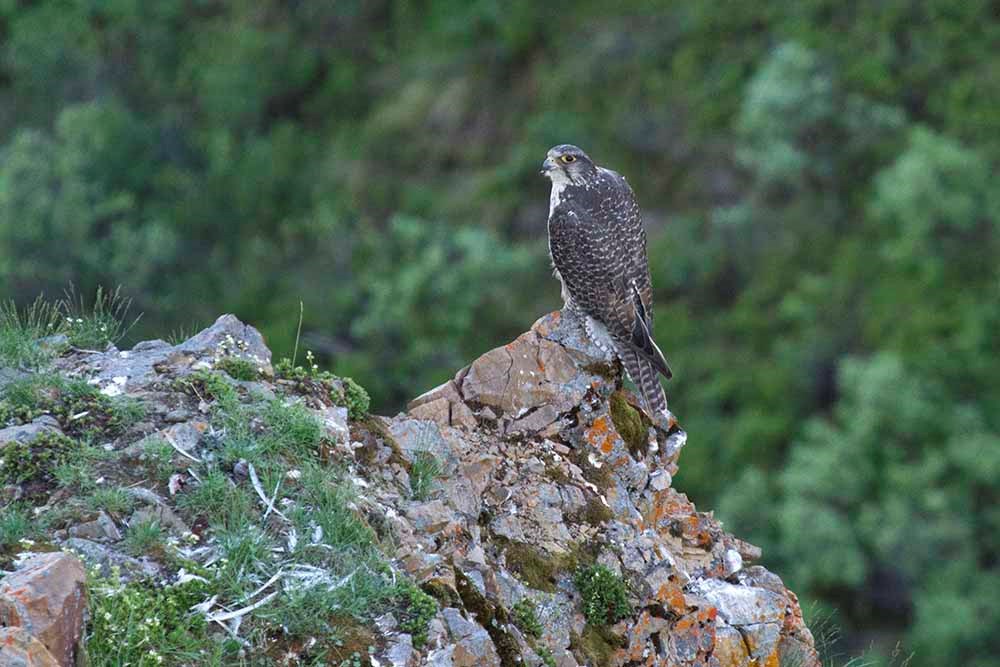
NPS/Jared Hughey
Alaska’s national parklands are home to an amazing diversity of birds ranging from black-capped chickadees (Poecile atricapillus) and Canada jays (Perisoreus canadensis) that remain relatively close to their natal areas throughout their entire lives to Arctic terns (Sterna paradisaea) and blackpoll warblers (Dendroica striata) that migrate tens of thousands of miles annually. Many species of migratory birds nest in Alaska’s national parklands, while others migrate through them or spend time in them during the non-breeding season or winter.
Brown and Elder (1982) eloquently stated in their book, This Last Treasure, Alaska National Parklands, “the national parklands in Alaska, some 50 million acres of them, hold in trust the closest approximation to complete ecosystems left on this planet.” As such, these areas are likely to become increasingly important for migratory birds as indirect and direct impacts of human activities spread across our planet. However, protecting migratory birds requires us to think and act far beyond the boundaries of these parklands; we need to work collaboratively with others to identify and protect the areas and resources they use throughout the year (Runge et al. 2014, 2015). Protecting our migratory birds also requires us to understand how events at any one stage of the life cycle, or the combined events at all stages, affect their population dynamics (Bowlin et al. 2010). Overall, we need to be proactive and apply life-cycle stewardship approaches for protecting our migratory birds. One step in doing so is learning more about the areas and resources they use throughout the year and their lives.
In this article, I review just a few of the recent advances in electronic tracking devices (or tags) that scientists are using to study migratory birds and highlight the results of a few recent studies that are providing new information on their movements. Tags provide new opportunities to identify the areas used by migratory birds throughout the year and assess how conditions and events at distinct geographic locations that are thousands of miles apart interact to affect their survival and reproductive success. Kays and others (2015) and McKinnon and Love (2018) suggested that we are in the golden age of animal tracking and bio-logging, where smaller and more sophisticated tracking technology allows the unprecedented study of animal movements. Others have suggested that tracking technology is still in its infancy, with many new advances being made every year (Bridge et al. 2013). Regardless, we hope that the results of studies using new tracking technology can be used to enhance conservation of migratory birds (Weidensaul 2017), including those found in Alaska’s national parklands.
New Technology Provides New Opportunities
The tools and technologies used to study bird movements is a rapidly evolving field. In this article, I briefly introduce four types of tracking devices (tags), that scientists are currently using to study the movements of wide-ranging migratory birds. The first two types of tags, satellite telemetry and global system for mobile communications (GSM) telemetry, remotely transmit data and do not require researchers to recover them to obtain data. The second two types of tags, archival light-level loggers (also known as geolocators) and global positioning system (GPS) data loggers, store data on board and require researchers to recover the tags to obtain data.
Over the past decade, tags available for studying the movements of birds and other wildlife have decreased in size, but in many cases increased in their data collection capabilities (see Kays et al. 2015). While these tags have been used to study the movements of a wide range of bird species, they are still limited to species that are large enough to carry the tag. For birds, a general rule is that the tag and materials used to affix it must be less than 3% of the weight of the bird (Caccamise and Hedin 1985).
The methods used to attach or affix tags to birds vary by species and by study; readers wanting to learn more about the various types of attachment methods should refer to specific studies. Further, tags are designed and sold by many different manufacturers; a list of the type of tags and their manufacturers is not included in this article.
Satellite and Global System for Mobile Communications Telemetry
Satellite telemetry systems rely on a series of polar-orbiting satellites to obtain data. Global System for Mobile Communication (GSM) telemetry systems rely on existing mobile cellular networks to obtain data. Both satellite and GSM tags can be equipped with many types of sensors including altimeters, thermometers, accelerometers, battery voltage meters, and solar-charging meters. Most current models of satellite Platform Transmitting Terminals (PTTs) and GSM tags also include a GPS sensor. Both types of tags can be programmed with specific duty cycles (the fraction of one period in which a signal is active) to allow researchers to collect and transmit data to their specification. Older PTT models were powered by batteries that had a limited life, but most newer models of PTTs and GSMs use solar rechargeable batteries that provide opportunities for tracking individuals for many years.
Satellite telemetry. Satellite telemetry was a major technological advancement for studying the movements of wide-ranging animals, including birds. This technology allowed researchers to remotely track tagged individuals nearly anywhere they traveled across Earth. Satellite tags (or PTTs) for birds became commercially available in the early 1990s. NPS scientists were among the first to use PTTs in Alaska to study bird movements (Britten et al. 1995). This system includes a PTT that is attached to the bird, a receiving system in space (the satellite), and a data receiving and transfer system on Earth. Today, most PTTs provide for highly precise locations determined by GPS.
GSM telemetry. GSM telemetry systems use cellular data networks to collect GPS-derived location and other (i.e., speed, heading, altitude) data. Tag locations are determined using GPS or Global Navigation Satellite Systems (GNSS). This technology became commercially available for use on birds about ten years ago. The system includes a transmitter/data logger that is attached to the bird and a receiving system, usually an existing cellular data network. GSMs can collect a tremendous amount of data and provide it to the user very quickly when a tag connects to a cellular network. When the tag cannot make a connection to a cellular network, the data are stored on board and sent when the tag makes the connection. GSM tags are very useful for studies that require large sample sizes of highly precise data for birds that pass within cellular networks.

Photo courtesy of Jared Hughey
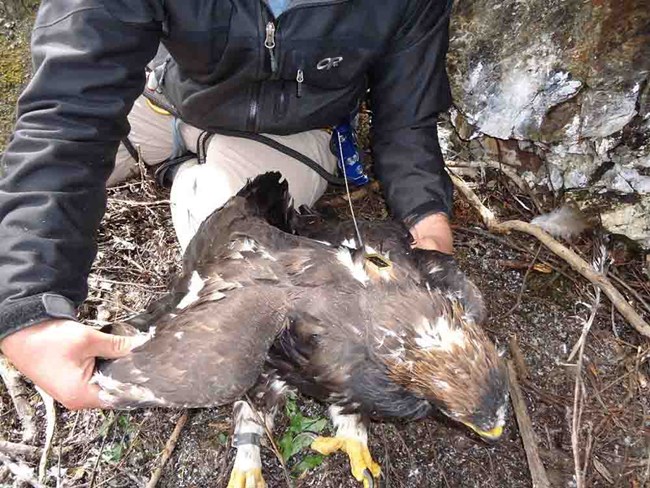
U.S. Fish & Wildlife Service/Stephen B. Lewis
A Sample of Studies Using Satellite and GSM Telemetry
Pre-breeding hotspots of Denali’s golden eagles on Alaska’s Arctic coastal plain. Golden eagles (Aquila chrysaetos) are a relatively long-lived species, but individuals most likely do not enter a breeding population until they are at least four to five years old (Watson 2010). Identifying areas used by younger golden eagles before they enter a breeding population is essential to the conservation of the species. Using lightweight battery-powered PTTs, McIntyre and others (2008) described the annual cycle movements of juvenile golden eagles that were raised at nests in Denali National Park and Preserve (Denali). These younger eagles were not members of the breeding population, but they returned to Alaska each spring to forage and perhaps prospect for future nesting opportunities. One of the most important, and surprising, results of the study was that some of the tagged eagles used portions of Alaska’s Arctic coastal plain in the summers before they entered a breeding population (McIntyre et al. 2008). In 2014, National Park Service (NPS) scientists in collaboration with scientists from the US Fish and Wildlife Service, US Geological Survey, and Conservation Science Global, LLC, continued studying the movements of golden eagles raised in Denali, this time instrumenting them with lightweight PTTs or GSM units with solar-rechargeable batteries just before they fledged (Figure 1; McIntyre 2015, McIntyre and Lewis 2018). The solar rechargeable PTTs and GSMs allowed scientists to track the movements of these younger eagles for multiple years. Like the eagles tagged in the earlier study, many of the eagles tagged in Denali after 2013 used portions of Alaska’s Arctic coastal plain during the summer (Figure 2; McIntyre and Lewis 2018). While use of this area by younger age classes of golden eagles was documented by Mauer (1985), Ritchie (2014), and Shook and Ritchie (2017), the historical and contemporary tracking studies demonstrated the strong link between golden eagles from Denali and Alaska’s Arctic coastal plain over decades.

[Figure from McIntyre and Lewis 2018.]
Trans-continental movements of juvenile gyrfalcons. Gyrfalcons (Falco rusticolus) nest throughout the circumpolar Arctic and Alaska contains the only nesting populations of gyrfalcons in the United States (Anderson et al. 2017). Using lightweight, battery-powered PTTs, McIntyre and others (2009) described the movements of juvenile gyrfalcons that were raised near Bering Land Bridge National Preserve and in Denali during their first few months of independence. The most significant findings of this study were that the tagged gyrfalcons exhibited a wide range of movement patterns during this period, including repeated movements from Alaska to Russia and use of coastal areas along the Chukchi and Bering seas.
Identifying the importance of off-shore waters for wintering long-tailed ducks. The coastal waters off many Alaska’s national parklands provide important staging and wintering areas for many species of migratory birds including waterfowl. Long-tailed ducks (Clangula hyemalis) nest in the circumpolar Arctic and migrate to cold, temperate coastal waters for the non-breeding season (Robertson and Savard 2020). Using lightweight battery powered PTTs, Bartzen and others (2017) studied the movements of 58 long-tailed ducks from nesting areas in Northwest Territories, Canada. The study identified important migration corridors, molting areas, and wintering areas in Alaska, including several near Alaska’s national parklands in southwest Alaska. The study’s findings suggest that conservation of long-tailed ducks requires cooperation among Canada, the USA, Russia, Japan, and South Korea—all countries that the tagged ducks used during their annual cycle (Bartzen et al. 2017).
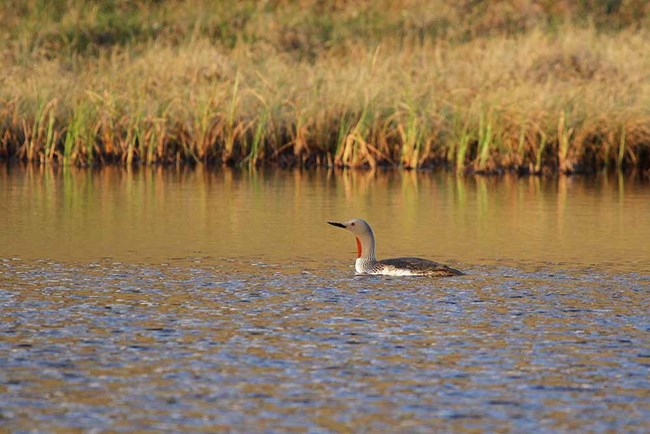
NPS/Jared Hughey
The East Asian connection of Alaska’s red-throated loons. Red-throated loons (Gavia stellata) are migratory waterbirds. They breed at high latitudes, nest in low densities on small ponds in coastal tundra ecosystems and spend most of the remaining year (about 8 months) on coastal marine waters (McCloskey et al. 2018). Using lightweight, battery-powered PTTs, McCloskey and others (2018) studied the annual movements of 38 red-throated loons from four breeding populations in Alaska. They discovered that the most northerly breeding population from the Arctic coastal plain, which has also exhibited population declines, generally migrated along the East Asian flyway, used stop-over sites on the northern edge of the Seward Peninsula near the Bering Land Bridge National Preserve, and overwintered in eastern Asia (Figure 3). In contrast, tagged loons from other nesting populations in Alaska migrated along the west coast of North America. These findings suggest that during much of the year, red-throated loons live in coastal and marine systems, including those that are often inundated with terrestrial-, atmospheric-, and marine-derived contaminants and pollutants (McCloskey et al. 2018). Identifying how these contaminants and pollutants affect survival and reproductive success is a key to understanding and mitigating them.

[Figure from McCloskey et al. 2018.]
Archival Data Loggers: Light-level Geolocators and GPS Data Loggers
Light-level geolocators and GPS data loggers became commercially available for use on birds in 2007. McKinnon and Love (2018) suggested that the availability of these smaller tags revolutionized the study of movements of birds that are too small (less than 0.7 ounces or 20 g) to carry PTTs or GSMs. Researchers attach these tags to birds using a variety of techniques (e.g., leg-loop backpack harness, nylon harness). Unlike PTT and GSM tags, these tags must be recovered to obtain the data stored on board.
Geolocators (Miniature Archival Light-level Logger). These tags currently range in weight from about 0.01-0.3 ounces (0.35 to 0.8 g) and offer scientists a tool to study the broader-scale movements of smaller birds (McKinnon and Love 2018). The tag includes a light sensor, internal clock, data- logging computer, and battery. Geolocators record light levels at regular intervals and store data on board; the archival data are obtained when the tag is recovered and locations are estimated by inferring solar positions (Bridge et al. 2013). Geolocators do not provide precise location data; because of error associated with unknown degrees of shading, a bird’s exact position cannot be determined using geolocators (Bridge et al. 2013). Estimates of the location accuracy vary but range up to 124 miles (200 km) in latitude and 93 miles (150 km) in longitude (Bridge et al. 2013). Further, latitudinal location estimates are unreliable on either side of the vernal and autumnal equinoxes (Hallworth and Marra 2015). Thus, these small tags are useful for answering questions that do not require highly precise location data.
Archival GPS Data Loggers. The smallest available GPS data logger weighs about 0.035 ounces (1 g) and are programmed to collect location data at specific times and dates. The locations are estimated by GPS, resulting in very high-resolution spatial data. However, the number of locations provided by the tag varies, depending on the model and the duty cycle. Overall, GPS data loggers provide highly precise locations but fewer locations than geolocators. The location data are stored on board and the tags must be recovered to obtain data.
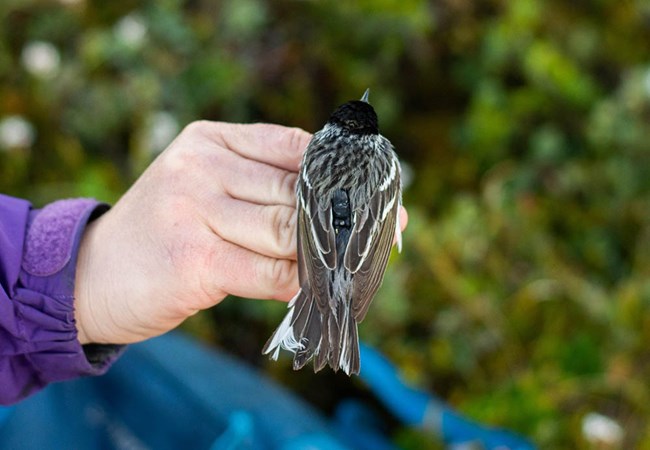
A Sample of Studies Using Geolocators and GPS Data Loggers
Hemispheric movements of blackpoll warblers. Blackpoll warblers are tiny (0.4 ounces or 12 g) passerine birds. Their breeding range spans the entirety of North America’s boreal forests. DeLuca and others (2019) described the movements of tagged blackpoll warblers from two study areas in Alaska (Nome and Denali) and two study areas in Canada (Whitehorse, Yukon, and Churchill, Manitoba; Figure 4). The study demonstrated that blackpoll warblers nesting in these areas undertake one of the longest migrations ever recorded for a passerine (DeLuca et al. 2019).
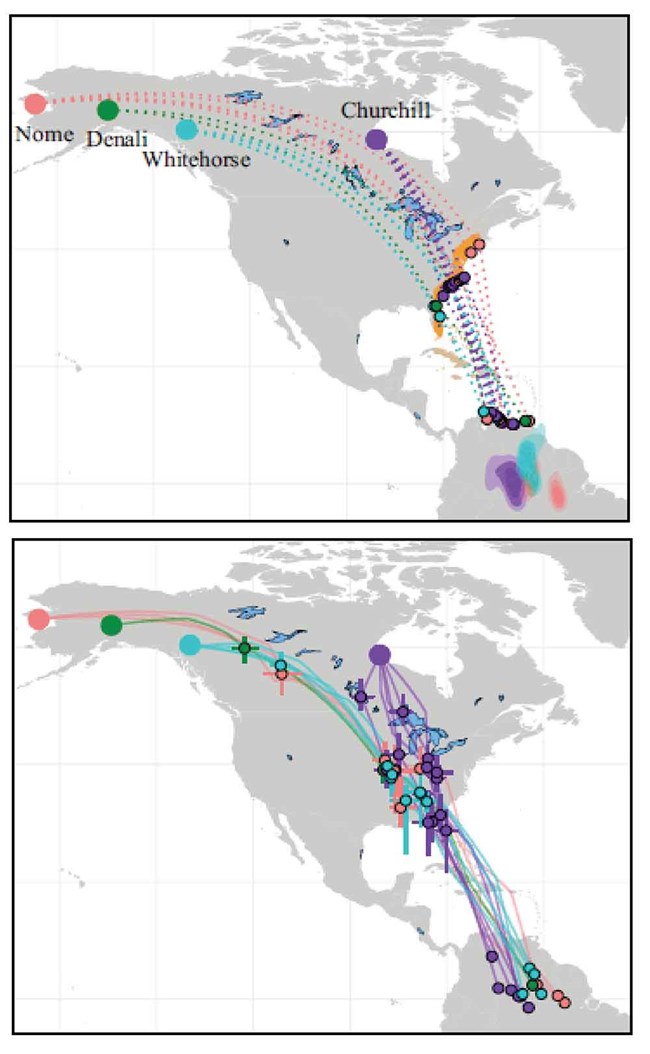
Spring migration of individuals, with points showing stopover sites (> 4 days) (bottom panel).
[Figure from DeLucca et al. 2019.]
After the nesting season, the tagged birds flew eastward across North America in 7 to 29 days, then laid over on the Atlantic coast in the United States for 18 to 41 days (Figure 5) as they prepared for the next stage of their autumn migration. They then embarked on a non-stop transoceanic flight to the north coast of South America—a trip ranging from 1,400-2,113 miles (2,250 to 3,400 km) that took just 48 to 96 hours to complete. The tagged birds overwintered in the northern Amazon basin. In spring, the tagged birds migrated back to their breeding grounds along what is close to the most direct route and completed the migration in 17 to 49 days (Figure 5). DeLuca and others (2019) suggested that loss or degradation of stopover habitats along the Atlantic coast of the US, northern Venezuela, and the Great Lakes basin could result in disproportionately wide-ranging effects on blackpoll warblers since they are used by individuals from across the breeding range.
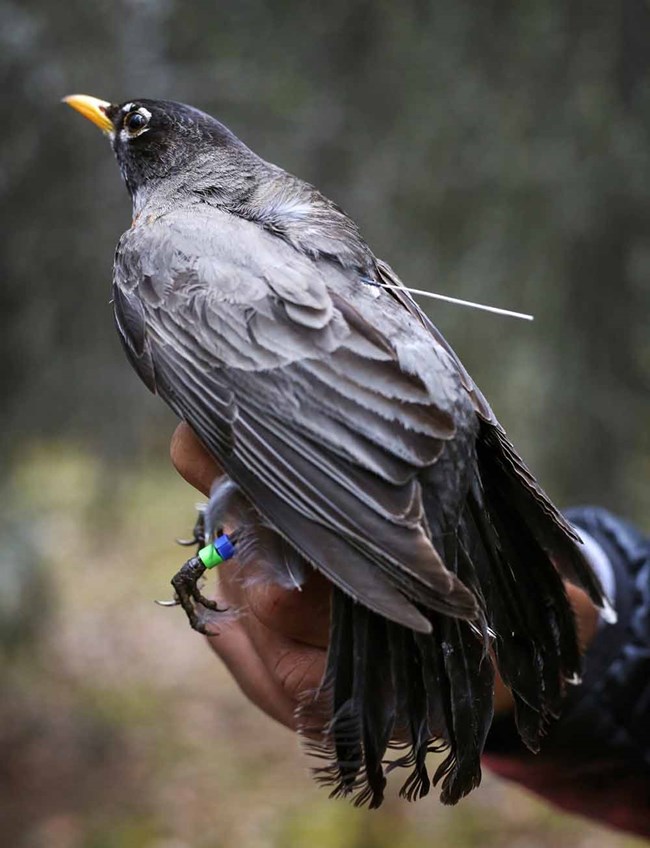
The color bands are visible using binoculars and help field staff identify which individuals should be targeted for recapture efforts when they return to Denali.
Continental movements of American robins and their behavioral response to environmental conditions during spring migration. Two recent studies used GPS data loggers to study the movements of American robins (Turdus migratorius), one of the most widespread birds in North America (Jahn et al. 2019, Oliver et al. 2020; Figure 6). Jahn and others (2019) studied the difference in migratory behavior of a very small sample of male American robins (n=7) in several study areas in North America. As predicated by encounters of banded birds (Brown and Miller 2016), four tagged male American robins from Denali migrated further than a female tagged in Massachusetts and a male and female tagged in Washington, DC, with Denali birds wintering from eastern Montana to northern Texas (Jahn et al. 2019; Figure 7). The timing of autumn migration events for the Denali birds was similar; all were in western Canada in mid-September and in the northern Great Plains in early October (Jahn et al. 2019).

[Figure from Jahn et al. 2019.]
Oliver and others (2020) documented migration routes and wintering areas of robins nesting in northwest North America, but also investigated if individual robins adjusted their migratory behavior in response to environmental conditions. Their study included 42 robins that were tagged and recaptured during migration in Alberta, Canada. The study results suggested that robins may fine-tune their northward rates of migration based not only on local environmental conditions along the way, forging ahead when and where environmental conditions permit, but also adjust their departure from overwintering grounds and migration rates according to broad-scale climatic conditions including snow cover, snow depth, and precipitation (Oliver et al. 2020).
Considerations for Wildlife Tracking
This article provides a brief introduction to four relatively new tracking tools that scientists are using to study movements of migratory birds that spend at least part of the year in Alaska. Weidensaul (2017) and McKinnon and Love (2018) provide excellent summaries of these and the many other tools that scientists are using to study bird movements including high-definition radar, stable isotope analysis, digitally coded radio-tags (very high frequency (VHF) nanotags), high-resolution genetic markers, and eBird. Wildlife tracking technologies are evolving rapidly, and readers should expect to see further advances and new technologies. For example, the collaborative and international MOTUS tracking system, while not described in this article, is providing many new opportunities for studying the movements of birds. Further, the newly develop ICARUS project also holds potential for studying the movements of wide-ranging birds.
Results of many tracking studies are providing new, and often exciting, results. However, it is extremely important for anyone thinking about tagging an individual with a tracking device to: (1) ensure that they are using the best methodology for answering the study questions; (2) review the literature to understand how the tags and attachment methods may affect individuals and, in turn, the study results; and (3) consult a biometrician to estimate the sample size of tagged individuals needed to answer the study question (Lindberg and Walker 2007). While we have made great advances in tracking the movements of wide-ranging birds, we still do not fully understand all the potential detrimental effects that birds may experience due to carrying tracking tags (Taff et al. 2018, Green et al. 2019). For example, return rates of birds tagged with geolocators may be lower than for birds that do not carry them and birds carrying tags may behave differently than untagged birds (Taff et al. 2018). Assessing the effects of a tag is an essential step in any movement study where tags are used. For tags that require the researcher to recapture the bird to obtain the data, it is also essential for researchers to understand the effort needed to recapture the bird, including the amount of area that should be included in recapture efforts. For example, two of the four tagged American robins in the Denali study were recaptured a mile or more (2 and 3.6 km) away from their original capture location (Jahn et al. 2019). Knowing the maximum distance that a robin would move between the initial capture and the recapture site provided researchers with information essential for adequately searching their study area for recapture efforts in subsequent year.
Beyond the Technology: Taking a Proactive Approach to Bird Conservation
While there are many new tools available for studying the movement of birds, it is important to remember that collecting the data is just one step toward conserving birds. We often get caught up in the excitement regarding new technology, but we need to be careful not to be blinded by it. A more important step happens long before the tags are ordered or deployed on birds. That step includes identifying the issue, developing questions, and designing a study (complete with a peer-reviewed study plan) that can answer those questions. Another essential step is sharing the data, either through publications, collaborations, or via online resources such as Movebank. A proactive approach to bird conservation that could be applied to Alaska’s national parks, is the concept of life-cycle stewardship. Life-cycle stewardship is defined as managing natural resources such that ecological processes or species’ full life cycles are sustained over time. For example, the North American Waterfowl Management Plan (has used range-wide and annual cycle approaches for management and conservation for decades. This approach is also being used and recommended by many other groups including Partners in Flight, the U.S. Shorebird Conservation Plan, Pacific Americas Shorebird Conservation Strategy, the East Asian-Australasian Flyway Partnership, and the Pacific Seabird Group. By applying a life-cycle stewardship approach using effective study plans and by collaborating with others, we can proactively work toward effective conservation of Alaska’s migratory birds. A proactive approach can help identify the impacts of environmental catastrophes such as the Deepwater Horizon oil spill that may have directly or indirectly impacted migratory shorebirds (Henkel et al. 2012) that nest in Alaska. A proactive approach may also provide opportunities for estimating how many of the estimated 599 million birds killed annually by collisions with buildings (Loss et al. 2014) or the 1.4 to 3.7 billion birds killed annually by free-ranging domestic cats in the U.S. (Loss et al. 2013) nest in Alaska’s national parklands. And, a proactive approach may allow us to estimate how many of the 12,000 to 35,000 shorebirds harvested annually in Barbados (Reed et al. 2018) nest in Alaska’s national parklands. These are examples of the types of issues we must investigate using well-designed scientific studies (National Parks Science Committee 2009) if we are to effectively protect the migratory birds that nest in Alaska’s national parklands.
References
Anderson, D. L., C. J. W. McClure, and A. Franke, editors. 2017.
Applied raptor ecology: Essentials from Gyrfalcon research. The Peregrine Fund, Boise, Idaho, USA.
Bartzen, B. A., D. L. Dickson, and T. D. Bowman. 2017.
Migration characteristics of long-tailed ducks (Clangula hyemalis) from the western Canadian Arctic. Polar Biology 40: 1085–1099.
Bowlin, M. S., I. A. Bisson, J. Shamoun-Baranes, J. D. Reichard, N. Sapir, P. P Marra, T. H. Kunz, D. S. Wilcove, A. Hendenström, C. G. Gugielmo, S. Åkesson, M. Ramenofsky, and M. Wikelsi. 2010.
Grand challenges in migration biology. Integrative and Comparative Biology 50:261-279.
Bridge, E. S., J. F. Kelly, A. Contna, R. M. Gabrielson, R. B. MacCurdy, and D. W. Winkler. 2013.
Advances in tracking small migratory birds: A technical review of light-level geolocation. Journal of Field Ornithology 84: 121-137.
Britten, M. W., C. L. McIntyre, and M. Kralovec. 1995.
Satellite radiotelemetry and bird studies in national parks and preserves. Park Science 15:20-24.
Brown, D. and G. Miller. 2016.
Band recoveries reveal alternative migration strategies in American Robins. Animal Migration 3: 35-47.
Brown, W. E. and C. Elder. 1982.
This Last Treasure, Alaska National Parklands. Alaska Natural History Association, Anchorage, Alaska.
Caccamise, D. F. and R. S. Hedin. 1985.
An aerodynamic basis for selecting transmitter loads in birds. Wilson Bulletin 97:306-318.
DeLuca, W. V., B. K. Woodworth, S. A. Mackenzie, A. E. M. Newman, H. A. Cooke, L. M. Phillips, N. E. Freeman, A. O. Sutton, L. Tauzer, C. McIntyre, I. J. Stenhouse, S. Weidensaul, P. D. Taylor, and D. R. Norris. 2019.
A boreal songbird’s 20,000 km migration across North America and the Atlantic Ocean. Ecology 100(05):e02651.
Green, G. R., R. A. Robinson, and S. R. Baillie. 2019.
Effects of tracking devices on individual birds – a review of the evidence. Journal of Avian Biology 50(2).
Hallworth, M. T. and P. P. Marra. 2015.
Miniaturized GPS tagsidentify non-breeding territories of a small breeding migratory songbird. Sci. Rep. 5: 11069.
Henkel, J. R., B. J. Sigel, and C. M. Taylor. 2012.
Large-scale impacts of the Deepwater Horizon Oil Spill: Can local disturbance affect distant ecosystems through migratory shorebirds? BioScience 62: 676-685.
Jahn, A. E., S. B. Lerman, L. M. Phillips, T. B. Ryder, and E. J. Williams. 2019.
First tracking of individual American robins (Turdus migratorius) across seasons. Wilson Journal of Ornithology 131(2): 356-359.
Kays, R., M. C. Crofoot, W. Jetz, and M. Wikelski. 2015.
Terrestrial animal tracking as an eye on life and planet. Science 348(6240): aaa2478.
Lindberg, M. S. and J. Walker. 2007.
Satellite telemetry in avian research and management: Sample size considerations. Journal of Wildlife Management 71:1002-1009.
Loss, S. R., T. Will, and P. P. Marra. 2013.
The impact of free-ranging domestic cats on wildlife of the United States. Nature Communications 4: 1396.
Loss, S. T. Will, S. S. Loss, and P. P. Marra. 2014.
Bird-building collisions in the United States: Estimates of annual mortality and species vulnerability. Condor 116: 8-23.
Mauer, F. 1985.
Distribution and relative abundance of golden eagles in relation to the Porcupine Caribou herd calving and post-calving periods, 1984. Pages 114-144 In Arctic National Wildlife Refuge Coastal Plain Resource Assessment, 1984 Update Report Baseline Study of the Fish, Wildlife and their Habitats, Volume I, Section 1002C, Alaska National Interest Lands Conservation Act. U.S.D.I, U.S. Fish and Wildlife Service, Region 7, Anchorage, Alaska.
McCloskey, S. E., B. D. Uher-Koch, J. A. Schmutz, and T. F. Fondell. 2018.
International migration patterns of red-throated loon (Gavia stellata) from four breeding populations in Alaska. PLoS ONE 13(1): e0189954.
McIntyre, C. L. 2015.
Conserving migratory golden eagles in a rapidly changing world: What role will the NPS play? Alaska Park Science 14(2): 16-21.
McIntyre, C. L. and S. B. Lewis. 2018.
Statewide movements of non-territorial golden eagles in Alaska during the breeding season: Information for developing effective conservation plans. Alaska Park Science 17: 65-73.
McIntyre, C. L., D. C. Douglas, and M. W. Collopy. 2008.
Movements of golden eagles (Aquila chrysaetos) from interior Alaska during their first year of independence. Auk 125:214-224.
McIntyre, C. L., D. C. Douglas, and L. G. Adams. 2009.
Movements of juvenile gyrfalcons from western and interior Alaska following departure from their natal areas. Journal of Raptor Research 43: 99-109.
McKinnon, E. A. and O. P. Love. 2018.
Ten years tracking the migrations of small landbirds: Lessons learning in the golden age of bio-logging. Auk 135:834-856.
National Parks Science Committee. 2009.
National Park Service science in the 21st century. Second edition. Report D-1589A. National Park Service, Lakewood, Colorado, USA.
Oliver, R. Y., P. J. Mahoney, E. Gurarie, N. Krikun, B. C. Weeks, M. Hebblewhite, G. Liston, and N. Boelman. 2020.
Behavioral responses to spring snow conditions contribute to long-term shift in migration phenology in American robins. Environmental Research Letters 15(4): 045003.
Reed, E. T., K. J. Kardynal, J. A. Horrocks, and K. A. Hobson. 2018.
Shorebird hunting in Barbados: Using stable isotopes to link the harvest at a migratory stopover site with sources of production. Condor 120: 357-370.
Ritchie, B. 2014.
Raptor surveys at lakes in the Foothill-Coastal Plain Transition, Colville to Kuk Rivers, NPR-A, Alaska, July 2012 and 2013. Unpublished report. ABR, Inc., Fairbanks, Alaska and Bureau of Land Management, Fairbanks, Alaska.
Robertson, G. J. and J. P. L. Savard. 2020.
Long-tailed duck (Clangula hyemalis), version 1.0. In Birds of the World (S. M. Billerman, Editor). Cornell Lab of Ornithology, Ithaca, NY, USA.
Runge, C. A., T. G. Martin, H. P. Possingham, S. G. Willis, and R. A. Fuller. 2014.
Conserving mobile species. Frontiers in Ecology and the Environment 12: 395-402.
Runge, C. A., J. E. M. Watson, S. H. M. Butchart, J. O. Hanson, H. P. Possingham, and R. A. Fuller. 2015.
Protected areas and global conservation of migratory birds. Science 350: 1255-1258.
Shook, J. E. and R. J. Ritchie. 2017.
Raptor surveys at lakes in the Foothill-Coastal Plain Transition, Colville to Kuk Rivers, NPR-A, Alaska, July 2016. Unpublished report. ABR, Inc., Fairbanks, Alaska and Bureau of Land Management, Fairbanks, Alaska.
Taff, C. C., G. R. Freeman-Gallant, H. M. Streby, and G. R. Kramer. 2018.
Geolocator deployment reduces return rate, alters selection, and impacts demography in a small songbird. PLoS ONE 13(12): e0207783.
Watson, J. 2010.
The Golden Eagle. Second edition. T. & A. D. Poyser, London, United Kingdom.
Weidensaul, S. 2017.
The New Migration Science. The Cornell Lab of Ornithology, All About Birds.; Available at: https://www.allaboutbirds.org/the-new-migration-science/ (accessed August 5, 2020)
Last updated: November 3, 2022
